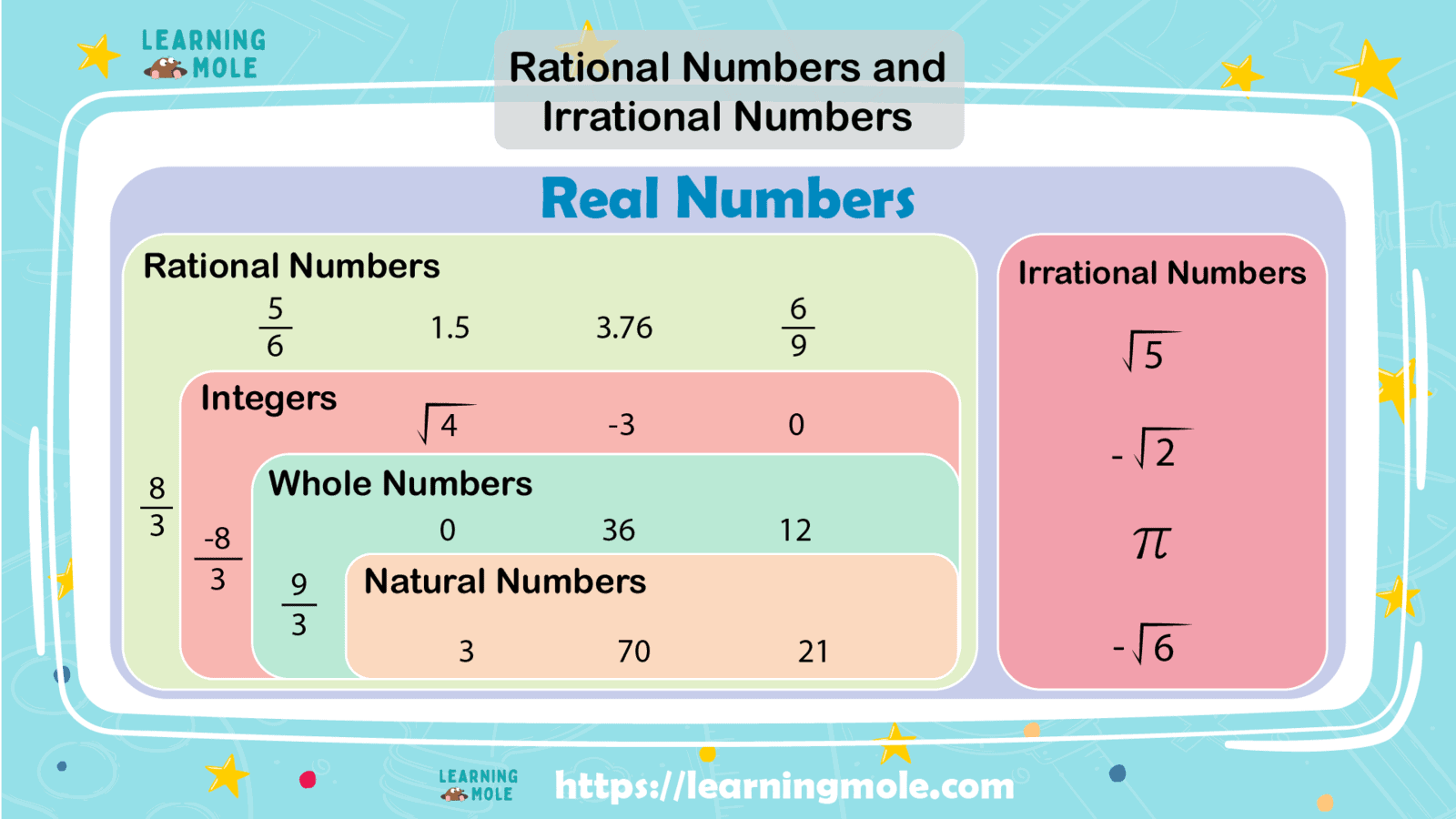
10 Interesting Facts about Rational Numbers
Before we start to know about rational numbers, let us remember what we learned from the set of different numbers.
Numbers are the language of mathematics, as they are used to express quantities and they are the basis of mathematics on which arithmetic operations are performed on a daily basis. For example, they are an essential part of money calculation, days, months, or years.
Table of Contents
Numbers
There are differences in the form of numbers. Their pronunciation and the way they are written in every culture and language are different. Just as every language is different from other languages according to culture. There are Arabic numbers and Indian numbers, but which are the numbers that form the mathematical symbols?
The role of scientists in the discovery and development of numbers greatly contributed. Most notably, was the Muslim scientist Al-Khwarizmi, who discovered the zero by which humans could count to infinity. So, we need to know more about numbers and how we can use them to solve the problems that face us in our lives.
Integers and Rational Numbers
One of the first numbers that scientists discovered were the numbers used for counting, whole numbers {1,2, 3……}, then the natural numbers {0,1,2, 3….}, followed by the integer numbers {…-3, -2, -1,0,1,2, 3…}, and ratio numbers.
Ratio numbers are one very common type of number that we usually study after integers in math. These numbers are written in the form of p/q, where p and q can be any integer and q ≠ 0. Mostly, people find it confusing to differentiate between fractions and ratio numbers because of the basic structure of numbers which is the p/q form.
Fractions are made up of whole numbers while ratio numbers are made up of integers as their numerator and denominator. Let’s learn more about ratio numbers.
Before we start the introduction of ratio numbers let us recall some basic mathematical rules. For two given integers a and b: their sum is a + b, their product is a × b, and their difference is a– b. They are always integers.
However, it may not always be possible for a given integer to be exactly divided by another given integer. This means that the result of the division of an integer by a non-zero integer may or may not be an integer. For example, when 7 is divided by 3, the result is not an integer since we know 7/3 is a fraction.
Thus, there is a need to extend the system of integers. So, that it may also be possible to divide any given integer by any other given integer that is not zero (because division by zero is not possible).
Now, we shall introduce the system of ratio numbers, the comparison of ratio numbers, various operations on ratio numbers, and the properties of these operations on ratio numbers.

Rational Numbers Tips and Tricks
- Ratio numbers are NOT only fractions but any number that can be expressed as a fraction
- Natural numbers, whole numbers, integers, fractions of integers, and terminating decimals are ratio numbers
- Non-terminating decimals with repeating patterns of decimals are also ratio numbers
- If a fraction has a negative sign either in the numerator or in the denominator or in front of the fraction, the fraction is negative. i.e., -a/b = a/-b.
The Rational Numbers in Mathematics
Do you know where the word “Rational” originated? It originated from the word “ratio”. So, rational numbers are very well related to the ratio concept of ratio.
Every integer is a rational number. You learned that the positive numbers, the negative numbers, and zero are called real numbers. So, the ratio numbers are all real numbers and can be positive or negative.
A number that is not rational is called an irrational number. An irrational number is any number that is not rational. It is a number that cannot be written as a ratio of two integers or cannot be written as a fraction.
π is an irrational number, but we will not explain it now, don’t worry. Most of the numbers that people use in their everyday lives are rational. These include fractions, integers, and numbers with finite decimal digits.
The Definition of Rational Numbers
A real number can be expressed as the quotient of two integers that are called ratio numbers. A rational number is a number that can be expressed as a fraction or a number that is in the form p/q, where p and q are integers and q is not equal to 0.
The set of ratio numbers is denoted by Q. In other words, if a number can be expressed as a fraction where both the numerator and the denominator are integers, the number is a rational number.
Examples of Rational Numbers
Remember that if a number can be expressed as a fraction where both the numerator and the denominator are integers, then the number is a rational number. Each number below is a rational number.
0=0/1 , 7=7/1 , 5 2/3=17/3 , 0.43=43/100, – 4/9=-4 /9
And also: 1/3, -2/5, 0.7 or 7/10, and -0.3 or -3/10.
There are different types of ratio numbers. We shouldn’t assume that only fractions with integers are ratio numbers.
Types of Rational Numbers
Decimals: 0.5, 0.4, 0.8, etc.
Fractions: 2/5, 1/3, 1/4, etc.
Percentage: 50%, 25%, 30%, etc.
Integers: -3.4, 5, etc.
Fractions whose numerators and denominators are integers like 3/7, -6/5, etc.
Terminating decimals like 0.35, 0.7116, 0.9768, etc. For example, -3/7, ½, 2/1
Non-terminating decimals, which are decimals with repeating patterns after the decimal point such as, 0.333…, 1.151515…,0.666…,0.09090909, etc.
A full understanding of ratio numbers for students involves an understanding of ratio numbers in all of their interpretations. These interpretations can be named in different ways, but in summary, they can be grouped under the headings or concepts of the quotient, measure, ratio, decimal, and operator. We can take any rational number (fraction). The purpose of this review is to discuss which rational number format students should learn first.
Ratio numbers can be represented with three related but different notations: fractions, decimals, and percentages. Each notation can express the multiple interpretations of a rational number.
Remember what we said about when we can write a number as a fraction? This will be a rational number. For example, 0.25 can be written as 25/100 which equals ¼ and that is also a rational number, and 3/4 = 75/100 = 0.75, 0.5 =5/10 = ½.
How to Identify a Rational Number?
In each of the above cases, the number can be expressed as a fraction of integers. Hence, each of these numbers is a rational number. To find whether a given number is a rational number or not, we can check whether it matches with any of these conditions:
- We can represent the given number as a fraction of integers
- All whole numbers are ratio numbers
Rational Numbers in Decimal Form
Ratio numbers can also be expressed in decimal form. Did you know that 1.1 is a rational number? Yes, it is because 1.1 can be written as 1.1= 11/10
Rational Numbers in Different Forms

We will learn how to find the rational number in different forms using the properties in expressing a given rational number.
- Express −3/10as a rational number with denominator 20.
Solution: In order to express −3/10as a rational number with denominator 20, we first find the number which when multiplied by 10 gives 20. Clearly, such a number = 20 ÷ 10 = 2
Multiplying the numerator and denominator of −3/10time 2, we have
−3/10= (−3) ×2/10×2 = −6/20Therefore, expressing −3/10as a rational number with denominator 20 is −6/20.
- Express −7/10as a rational number with denominator -30.
Solution: In order to express −7/10 as a rational number with denominator -30, we first find a number that when multiplied by 10 gives -30. Clearly, such a number is = (-30) ÷ 10 = -3.
Multiplying the numerator and denominator of −7/10by -3, we have−7/10= (−7) × (−3)/10 ×(−3) = 21/−30
Therefore, expressing −7/10as a rational number with denominator -30 is 21/−30.
- Express 42/−63 as a rational number with denominator 3.
Solution:
In order to express 42/−63 as a rational number with denominator 3, we first find a number that gives 3 when -63 is divided by it.
Clearly, such a number = (-63) ÷ 3 = -21
Dividing the numerator and denominator of 42/-63 by -21, we get
42/−63 = 42÷ (−21) / (−63) ÷ (−21) = −2/3
Therefore, expressing 42/−63 as a rational number in different forms with denominator 3 is −2/3.
Operations on Rational Numbers
Addition of Ratio Numbers
When the denominators of the given ratio numbers are equal:
We add the numerators and keep the denominators the same.
E.g 3/10 + 4/10 = 7/10
When the denominators of given numbers are unequal:
We must use two steps to add two unequal denominators;
-We must find the LCM of the denominator. The LCM of 4 and 5 is 20.
-We must then convert each rational number into the same denominator.
E.g 3/4 + 3/5 = 3×5/20 + 3×4/20
15/20+ 12/20= 27/20
Subtraction of Ratio Numbers
When the denominators of the given numbers are equal:
Subtract the numerators and keep the denominator the same.
E.g 4/5 – 2/5 = 2/5
When the denominators of the given numbers are unequal:
We must find the LCM of the denominator. In this example, the LCM of 2 and 3 is 6.
We must convert each fraction into a rational number with the same denominator.
E.g ½ – ⅔ = 1×3/6 – 2×2/6
4/6 – 3/6 =1/6
Multiplication of Rational Numbers
To multiply two ratio numbers, you must multiply the numerator and denominator of the first rational number with the numerator and denominator of the second rational number.
E.g 4/5 x 2/3 = 4×2= 8, 5×3= 15 = 8/15
Division of Rational Numbers
To divide two ratio numbers, you must multiply one rational number by the inverted rational number.
E.g 2/3 divided by 1/5= 2/3 X 5/1 (flip the second fraction upside down), then do your steps of multiplication, 2×5=10, 3×1=3 = 10/3
Comparison between Rational Numbers
We will learn now about the comparison between rational numbers. We know how to compare two integers and also two fractions. We know that every positive integer is greater than zero and every negative integer is less than zero.
Also, every positive integer is greater than every negative integer. Similar to the comparison of integers, we have the following facts about how to compare ratio numbers, and before you make any comparison between two ratio numbers you must remember these facts.
- Every negative rational number is less than 0
- Every positive rational number is greater than every negative rational number
- Every rational number represented by a point on the number line is greater than every rational number represented by points on its left
- Every rational number represented by a point on the number line is less than every rational number represented by paints on its right
How to compare the two ratio numbers? In order to compare any two ratio numbers, we can use the following:
1: Obtain the given ratio numbers
2: Write the given ratio numbers so that their denominators are positive
3: Find the LCM of the positive denominators of the ratio numbers
4: Express each rational number (obtained in 2) with the LCM (obtained in 3) as a common denominator
5: Compare the numerators of ratio numbers obtained in the previous step. The number that has a greater numerator is the greater rational number
Examples:
1. Which of the two ratio numbers 1/2 and −2/3is greater?
Solution:
Clearly, 1/2 is a positive rational number, and −2/3is a negative rational number.
We know that every positive rational number is greater than every negative rational number. Therefore, 1/2 > −2/3.
2. Which rational number is greater, 3/−5 or −5/6?
Solution:
We write each of the given numbers with a positive denominator.
First number: 3/-5 = 3× (−1)/ (−5) × (−1) = −3/5
The other number = −5/6.
L.C.M. of 5 and 6 = 30
Therefore, −3/5= (−3) ×6/5×6 = −18/30 and −5/6 = (−5) ×5/6×5 = −25/30
Clearly, -18/30 > −25/30 Hence, 3/-5 > -5/6
3. Which rational number is greater 5/6 or 3/4?
Solution:
Clearly, denominators of the given ratio numbers are positive. The denominators are 6 and 4. The LCM of 6 and 4 is 12. So, we first express each rational number with 12 as a common denominator.
Therefore, 5/6 = 5×2/6×2 = 10/12 and 3/4 = 3×3/4×3 = 9/12
We compare the numerators of these ratio numbers.
Therefore, 10 > 9⇒ 10/12 > 9/12 ⇒ 5/6 > 3/4.
5. Which rational number is greater −4/5or 5/−7?
Solution:
First, we write each one of the given ratio numbers with a positive denominator.
Clearly, the denominator of −4/5 is positive, the denominator of 5/−7 is negative.
So, we express it with a positive denominator as follows:
5/−7= 5× (−1)/ (−7) × (−1) = −5/7, [Multiplying the numerator and denominator time -1]
Now, the LCM of denominators 5and 7 is 35.
We write the ratio numbers so that they have a common denominator 35 as follows:
−4/5 = (−4) ×7/5×7 = −28/35 and, −5/7 = (−5) ×5/7×5 = −25/35
Therefore, -25 > -28 ⇒ -25/35 > -28/35 ⇒ −5/7> −4/5 ⇒ 5/-7> −4/5.
For all integers a and b and all positive integers c and d;
- a/c >b/d if and only if ad >b c.
- a/c < b/d if and only if ad <b c.
Thus, 4/7 > 3/8 because (4×8) > (3×7).
7/9 < 4/5 because (7×5) < (4×9).
Arrange the Rational Numbers in Ascending Order
We will learn how to arrange ratio numbers in ascending order. The general method is to arrange from the smallest to the largest ratio numbers (increasing):
1: Express the given ratio numbers with a positive denominator
2: Take the least common multiple (L.C.M.) of this positive denominator
3: Express each rational number (obtained in step 1) with this least common multiple (LCM) as the common denominator
4: The number having the smaller numerator is smaller.
Examples:
1. Arrange the ratio numbers −7/10, 5/−8, and 2/−3 in ascending order:
Solution:
We first write the given ratio numbers so that their denominators are positive.
We have,
5/−8 = 5× (−1)/ (−8) × (−1) = −5/8 and 2/−3 = 2× (−1)/ (−3) × (−1) = −2/3
Thus, the given ratio numbers with positive denominators are
−7/10, −5/8, −2/3
Now, LCM of the denominators 10, 8 and 3 is 2 × 2 × 2 × 3 × 5 = 120
We now write the numerators so that they have a common denominator 120 as follows:
−7/10= (−7) ×12/10×12= −84/120,
−5/8= (−5) ×15/8×15 = −75/120 and
−2/3= (−2) ×40/3×40 = −80/120
Comparing the numerators of these numbers, we get,
– 84 < -80 < -75
Therefore, −84/120< −80/120< −75/120⇒ −7/10< −2/3< −5/8
⇒ −7/10< 2/−3 < 5/−8
Hence, the given numbers when arranged in ascending order are:
−7/10, 2/−3, 5/−8
2. Arrange the ratio numbers 5/8, 5/−6, 7/−4, and 3/5 in ascending order.
Solution:
First, we write each one of the given ratio numbers with a positive denominator.
Clearly, denominators of 5/8 and 3/5 are positive.
The denominators of 5/−6 and 7/−4 are negative.
So, we express 5/−6 and 7/−4 with positive denominator as follows:
5/−6 = 5× (−1)/ (−6) × (−1) = −5/6 and 7/−4 = 7× (−1)/ (−4) × (−1) = −7/4
Thus, the given ratio numbers with positive denominators are
5/8, −5/6, −7/4 and 3/5
Now, LCM of the denominators 8, 6, 4 and 5 is 2 × 2 × 2 × 3 × 5 = 120
Now we convert each of the ratio numbers to their equivalent rational number with common denominator 120 as follows:
5/8 = 5×15/8×15,
[Multiplying the numerator and denominator by 120 ÷ 8 = 15]
⇒ 5/8 = 75/120
−5/6= (−5) ×20/6×20,
[Multiplying the numerator and denominator by 120 ÷ 6 = 20]
⇒ −5/6= −100/120
−7/4 = (−7) ×30/4×30,
[Multiplying the numerator and denominator by 120 ÷ 4 = 30]
⇒ −7/4= −210/120 and
3/5 = 3×24/5×24,
[Multiplying the numerator and denominator by 120 ÷ 5 = 24]
⇒ 3/5 = 72/120
Comparing the numerators of these numbers, we get,
-210 < -100 < 72 < 75
Therefore, −210/120< −100/120< 72/120 < 75/120
⇒ −7/4< −5/6< 3/5 < 5/8 ⇒ 7/−4 < 5/−6 < 3/5 < 5/8
Hence, the given numbers when arranged in ascending order are:
7/−4, 5/−6, 3/5, 5/8.
3. Write the following ratio numbers in Ascending Order
-3/5, -1/5, -2/5
Solution:
Since all the numbers have a common denominator the one with a smaller numerator is the smaller rational number. However, when it comes to negative numbers the higher one is the smaller one.
Therefore, arranging the given ratio numbers, we get -3/5, -2/5, -1/5
4. Arrange the ratio numbers 1/2, -2/9, -4/3 in Ascending Order?
Solution:
Find the LCM of the denominators 2, 9, 3
LCM of 2, 9, and 3 is 18
Express the given ratio numbers with the LCM in terms of common denominator.
1/ 2= 1×9/2×9 = 9/18
-2/9 = -2×2/9×2 = -4/18
-4/3 = -4×6/3×6 = -24/18
Check the numerators of all the ratio numbers expressed with a common denominator.
Since -24 is less than the other two we can arrange the given ratio numbers in Ascending Order. -24/18, -4/18, 9/18
-4/3, -2/9, 1/2 is the Ascending Order of Given Ratio Numbers.
5. Arrange the Ratio Numbers 5/8, 4/-6, 3/5 in ascending order?
Solution:
Firstly, express the ratio numbers with positive denominators by multiplying with -1
4/-6 = 4× (-1) /-6× (-1) = -4/6
So, find the LCM of the denominators 8, 6, 5
LCM of 8, 6, and 5 is 120
5/8 = 5×15/8×15 = 75/120
-4/6 = -4×20/6×20 = -80/120
3/5 = 3×24/5×24 = 72/120
Check the numerator of the ratio numbers having common denominators.
Since -80 is the smallest that itself is the smallest rational number.
Therefore, 4/-6, 3/5, 5/8 are in Ascending Order.
Arrange the Rational Numbers in Descending Order
We will learn how to arrange ratio numbers in descending order. The general method is to arrange from the largest to the smallest ratio numbers (decreasing): we use the same steps from when we arranged in ascending order
1: Express the given ratio numbers with a positive denominator
2: Take the least common multiple (L.C.M.) of this positive denominator
3: Express each rational number with this least common multiple (LCM) as the common denominator
4: The number having the greater numerator is greater.
Examples:
Example: 1 Arrange the numbers −3/5, 7/−10and −5/8 in descending order.
Solution: First we write each of the given numbers with a positive denominator.
We have;
7/−10 = 7× (−1) / (−10) × (−1) = −7/10.
Thus, the given number is −3/5, −7/10and −5/8.
L.C.M. of 5, 10, and 8 is 40.
Now, −3/5= (−3) ×8/5×8= −24/40;
−7/10= (−7) ×4/10×4= −28/40 And −5/8= (−5) ×5/8×5= −25/40
Clearly, −24/40> −25/40> −28/40
Thus, −35> −5/8> −7/10, i.e., −3/5> −5/8> 7/−10
Hence, the given numbers when arranged in descending order are −3/5, −5/8, and 7/−10.
2. Arrange the following ratio numbers in descending order: 4/9, −5/6, −7/−12, and 11/−24.
Solution:
First, we express the given ratio numbers in the form so that their denominators are positive.
We have,
−7/−12= (−7) × (−1) / (−12) × (−1) ,
[Multiplying the numerator and denominator by -1]
⇒ −7/−12= 7/12 and
11/−24= 11× (−1) / (−24) × (−1) = −11/24
Thus, given ratio numbers are:
4/9, −5/6, 7/12, −11/24
Now, we find the LCM of 9, 6, 12, and 24.
Required LCM = 2 × 2 × 2 × 3 × 3 = 72.
We now write the ratio numbers so that they have a common denominator 72.
We have,
4/9 = 4×8/9×8,
[Multiplying the numerator and denominator by 72 ÷ 9 = 8]
⇒ 4/9 = 32/72
−5/6= −5×12/6×12,
[Multiplying the numerator and denominator by 72 ÷ 6 = 12]
⇒ −5/6= −60/72
7/12 = 7×6/12×6,
[Multiplying the numerator and denominator by 72 ÷ 12 = 6]
⇒ 7/12 = 42/72
−11/24= −11×3/24×3, [Multiplying the numerator and denominator by 72 ÷ 24 = 3]
⇒ −11/24= −33/72
Arranging the numerators of these ratio numbers in descending order, we have
42 > 32 > -33 > -60
⇒ 42/72 > 32/72 > −33/72 > −60/72⇒ −7/−12> 4/9 > 11/−24 > −5/6
Hence, the given numbers when arranged in descending order are:
−7/−12, 4/9, 11/−24, −5/6.
3. Arrange the ratio numbers −7/10, 5/−8, and 2/−3 in descending order:
Salutation: First we write each one of the given ratio numbers with a positive denominator.
We have,
5/−8 = 5× (−1)/ (−8) × (−1) = −5/8 and 2/−3 = 2× (−1)/ (−3) × (−1) = −2/3
Thus, the given ratio numbers with positive denominators are
−7/10, −5/8, −2/3
Now, LCM of the denominators 10, 8 and 3 is 2 × 2 × 2 × 3 × 5 = 120
We now write the numerators so that they have a common denominator 120 as follows:
−7/10= (−7) ×12/10×12= −84/120,
−5/8= (−5) ×15/8×15 = −75/120 and
Comparing the numerators of these numbers, we get,
-75>-80>-84
Therefore, -75/120 > -80/120 > -84/120 ⇒ -5/8 > -2/3 >-7/10
Hence, the given numbers when arranged in descending order are:
5/-8 >2/-3 > -7/10
Frequently Asked Questions
Is 0 a rational number?
Yes, 0 is a rational number as it can be written as a fraction of integers like 0/1, 0/-2… Etc.
What defines a rational number?
Any number that can be written as a ratio or fraction of two integers is a rational number.
How many types of ratio numbers are there?
There are four types of ratio numbers. These are fractions, decimals, integers, terminating decimals and ratio numbers.
What is an irrational number?
An irrational number is a real number which cannot be written in the form of a fraction.

In the end, we try to summarize the relationship between the different numbers and the set of ratio numbers. This includes all the sets of numbers that you have studied before. We will expand on by learning more about the set of ratio numbers, their properties, and the arithmetic operations. Check out our premium courses for children.


Leave a Reply